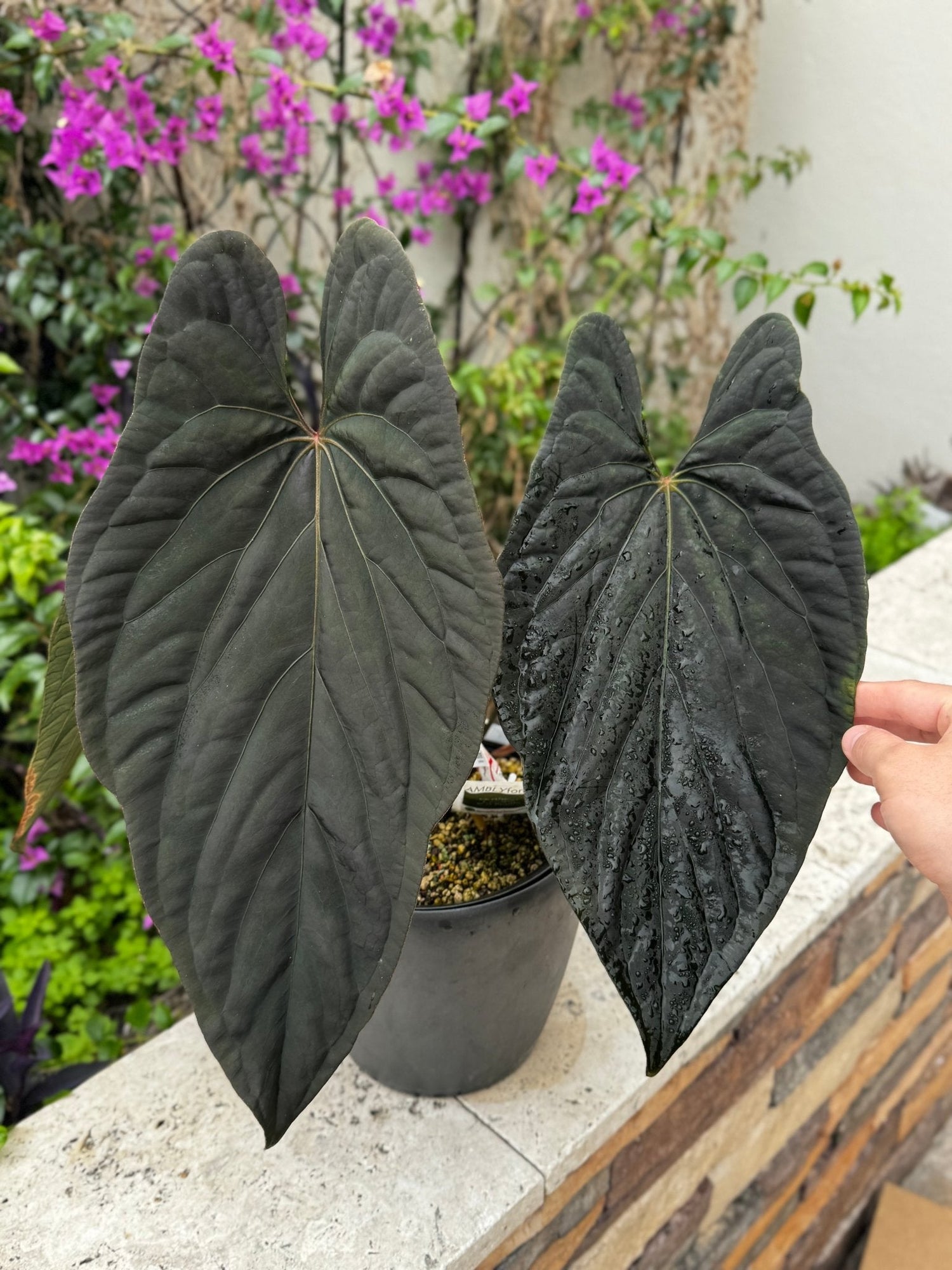I wanted to compile some information about inflorescences and pollination as I see a lot of questions about these topics and there isn’t a lot of great information online in one place. Some things I’ll cover in this post are: basic inflorescence structure, the female and male phases, pollen collection and storage, pollination and berry/seed harvesting.
What is an inflorescence?
An inflorescence (commonly called “inflo” for short) is the reproductive structure of anthuriums and is comprised of two structures, the spathe and the spadix. The inflorescence is often referred to as a “flower” but this is not accurate as the actual flowers are tiny and numerous and distributed along the surface of the spadix. The spathe is a modified leaf which encases the spadix and retracts before female anthesis (female receptive phase). The inflorescence is supported by the peduncle.

Reproductive phases
Anthuriums have perfect flowers meaning each flower has both female and male parts rather than having separate male and female flowers. Each flower undergoes a female receptive phase followed by the male pollen producing phase. This order helps prevent self pollination on an inflo.
Some time after the spathe retracts, the female/receptive phase will begin. This is signaled by tiny droplets of stigmatic fluid appearing on the flowers along the surface of the spadix. It is during this time that pollen can be applied. Typically the fluid starts at the base of the spadix and progresses towards the tip. In my experience this is variable but typically lasts around 1-2 days (but don’t hold me to this). Below is a photo of a dressleri inflo which has just entered receptive phase with small droplets along the base extending up to the mid portion of the spadix.

After a period of time, the inflorescence will no longer be receptive and the flowers will transition to male anthesis which is the pollen production phase. The time between the end of the receptive phase and the beginning of the male pollen production phase can be pretty variable depending on the species/hybrid but in my experience it can be as short as the next day and as long as a week or more. Below is a picture of an anthurium dressleri inflo that has entered the male pollen production phase. Powdery white pollen can be seen clinging to the small green flowers along the spadix. The spadix has also changed color from green to yellow which is typical of dressleri and a number of other species.
 ‘
‘
Following the male phase, one of two things will happen with the inflo. If no successful pollination occurred during the preceding female phase, the inflo will abort after a period of time. The earliest sign of an aborting Inflo I have noticed is yellowing along the peduncle. This is usually followed by abnormal color changes and softening of the spadix. If a successful pollination occurred, the inflo will gradually undergo a series of morphological changes. The most obvious of these is a color change followed by gradual development of berries within the successfully pollinated flowers along the spadix. Below is a picture of a successfully pollinated dressleri inflo. The spadix has turned back from yellow to a dark green as is typical of dressleri. There has also been enlargement of the “spikes” on the spadix which correspond to the pollinated flowers which will eventually develop into berries. There has also been a slight swelling/widening of the spadix. Once the inflo has been successfully pollinated and begins the process of making berries it is more precisely referred to as an “infructescence”.

Collecting and storing pollen
Once the inflo begins producing pollen it’s time to start collecting the pollen. There are a number of slight variations on technique and tools used for this but I will show mine here which I think are pretty in line with what the majority of people are doing as well.
Here is a pap inflo in male pollen production phase. I use black origami paper folded in half (suggested to me by Justin Jones and much better than the foil I had been using previously) and brush the pollen gently off with cheap thin disposable paint brush into the crease (I couldn’t show myself brushing the pollen off due to only having two hands).


Next I direct the stray pollen into the crease and then brush it carefully into a small 1.5 mL plastic microcentrifuge tube. I then place the tube, the brush, the origami paper and a silica dessicant packet into a labeled freezer zip lock bag and into the freezer for future use. I typically start collecting within a day or two and continue collecting every day or two while the plant is producing pollen. If the inflo is producing a large amount of pollen I will often collect into multiple tubes over multiple days to use for multiple future projects. I have successfully used pollen as old as 8 months and have heard that it can be used as much as 12 months after collection.



Pollination
Pollination is fairly straight forward. Take the pollen you want, either fresh from another inflo or stored from previous harvest, and apply it with a brush to the target inflo once it is receptive. I typically will wait until stigmatic fluid covers approximately 2/3rds of the inflo before first applying pollen (remember it will begin at the base and progress towards the tip). Pollinating too early can result in a lower coverage of the inflo than desired and waiting too long can result in missing the receptive window entirely. I will often reapply for a day or two, particularly if I still see some flowers producing stigmatic fluid.
Miscellaneous tid bits
Here are some facts and observations that might be of interest but didn’t fit nicely into the flow of the main write up:
*An inflo entering pollen phase after attempted pollination DOES NOT mean the pollination was unsuccessful. Some plants, however, will produce less or no pollen after being successfully pollinated. I have noticed this particularly in more immature plants and also plants that are already holding other pollinated inflos.
*Some immature inflos, especially first inflos, will skip (or at least appear to skip) receptive phase and may produce very little pollen or pollen with a coarse texture making it difficult to use.
*Many people avoid pollinating the first inflo and I generally do as well. I have pollinated some first inflos successfully but its just usually a matter of the size of the inflo and how I think the plant will handle it from a maturity standpoint.
*Producing seed can be VERY taxing on a plant. How taxing seems to depend on the species, the maturity of the plant and how many infructescences are being held simultaneously.
*A totally made up rule for pollinating multiple inflos that has worked pretty well for me is you can pollinate one inflo for every 3 healthy leaves a plant is holding. I violate this all the time but I’ve never had a plant that satisfies this rule crash while producing berries.



